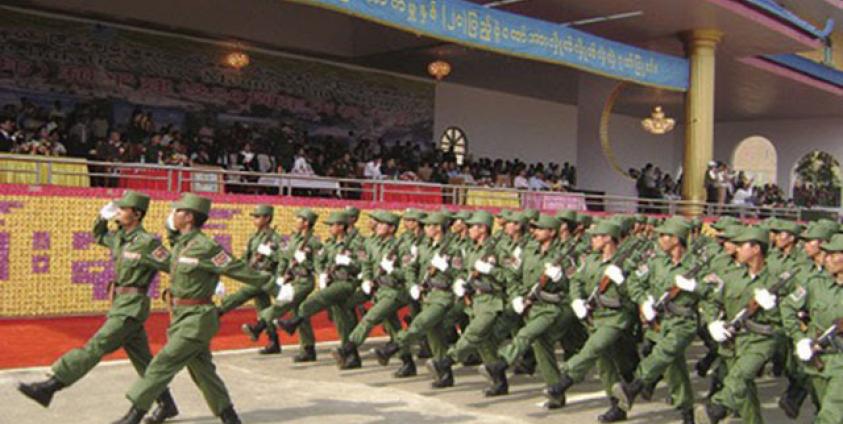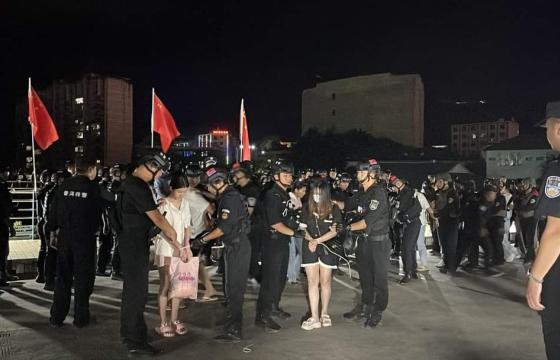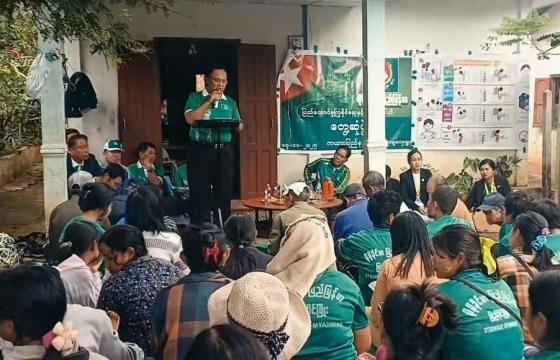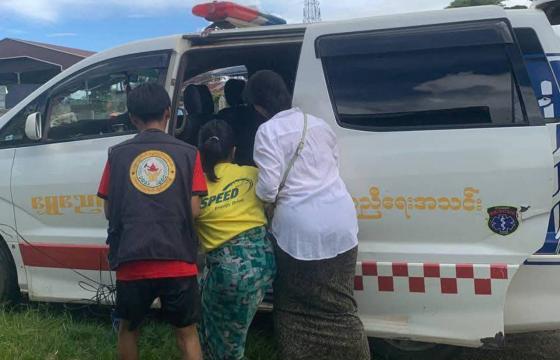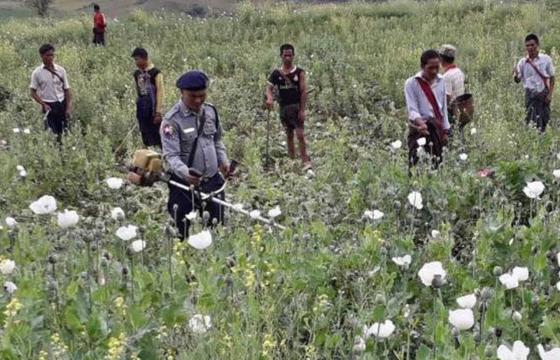United Wa State Army (UWSA) planned 30th anniversary of signing ceasefire with the then military government is scheduled to be held from April 15 to 17 which will coincide with the Water festival or Thin Gyan in Myanmar. Whatever the case the ceasefire signed on May 9, 1989 will be celebrated with pomp and splendor, with dignitaries invited.

Photo by SHAN- the United Wa State Army (UWSA) soldiers march on the 20th anniversary in the Headquarters Pangsang in 2009.
The invitation list hasn’t been made public but piecing it from news media and statements from UWSA sources, it can be concluded that the Myanmar government-military top characters will be invited.
Reportedly, Sun Guo-Xiang, special envoy for Asian affairs of the Chinese foreign ministry, will attend the UWSA’s 30th anniversary of peace celebration, according to the UWSA’s liaison office in Lashio. Likewise, state counselor Aung San Suu Kyi, commander-in-chief Min Aung Hlaing and senior leaders of the Naypyitaw government will be invited, according to China-Myanmar Economic Cooperation and Development Promotion Association on January 18.
The purpose of such a celebration is explained by Nyi Rang, spokesperson of UWSA and head of the northern Shan state’s Lashio liaison office as: “Our region has been peaceful for many years. We strongly want it to remain peaceful and to understand the value of peace; therefore, we celebrate it,” according to The Irrawaddy report of August 17, 2018.
The UWSA intends to complete construction of a paved road network through the Wa region by the time of the celebration to show that the area has developed in the 30 years since the ceasefire.
“We are working hard to complete paved roads in the Wa region,” Nyi Rang said.
For the preparation, the UWSA has been training some 500 youths, both male and female, for the military parade and for traditional cultural music and dance performances at the event, aged from 15 to 20 for the last eight-nine months from 10 townships under its control.
Accordingly, girls and women selected to perform in the parade have to train for nine months in preparation—parents of recruits say that this involves marching, reception, and coordinated performances, reported SHAN on August 7, 2018.
Conscription allegedly began in July 2018 in Pangwai, Nar Pan, Mongmaw, and in areas along the Thai-Burma border, with training started earlier in August 2018.
“They told me to send my daughter on July 23,” said Aik Kap, a father of a new recruit from Hotawng. “They don’t allow me to see my daughter in the training camp. It’s not right for parents to not be able to see their children,” he added.
Aik Kap said that some youth had fled across the border to China upon hearing that girls were being recruited into the UWSA.
The United Wa State Army (UWSA) soldiers march on the 20th anniversary in the Headquarters Pangsang in 2009.
Background
On April 17, 1989, the Wa soldiers within the Communist Party of Burma (CPB) mutinied and took over the Panghsang (now renamed Pangkham) headquarters putting an end to the decades-long CPB movement, although the Communist Party of China (CPC) tried in vain to breath life into it after the mutiny.
Following the mutiny most non-Wa CPB members chose to go to China, but the party’s leader, Thakin Ba Thein Tin, who was ill and bedridden, had to be forcefully evicted as he did not want to leave his homeland.
CPB troops were reorganized on Chinese territory, provided with weapons and re-deployed to Burma, in a territory of eastern Kachin state, to join a group controlled by two defectors from the Kachin Independence Army (KIA). But when this group agreed to a ceasefire with the Tatmadaw (Myanmar Army) shortly afterwards, the CPB was forced to seek refuge again in China, where aging party members continue to be cared for by China, wrote Sithu Aung Myint recently in Frontier Myanmar.
After the mutiny the Wa signed an agreement with the junta in May 1989 which has proven to be remarkably durable.
The establishment of UWSA with some 30,000 troops and 10,000 auxiliary members as the strongest ethnic army headed by Bao Youxiang started out 30 years ago in 1989, which is intertwined with the historical development of the CPB.
The emergence of the UWSA can be traced to the anti-Chinese riots that broke out in Rangoon (Yangon) on 26 June 1967. The riots resulted from Chinese students’ defiance of the Burmese government’s ban on wearing Mao badges in school, at the height of the culture revolution, led to the deterioration of Sino–Burmese relations and subsequent shift of China’s foreign policy which included open intervention in Burma’s civil war.
The riots that erupted violently affecting the ethnic Chinese people and other Chinese targets, including the embassy of the People’s Republic went on for several days until the government of General Ne Win declared martial law and sent in troops to restore order. The delay and inaction infuriated Beijing, so much so that it responded with an invasion on January 1, 1968.
A coalition force, which included troops from the CPB and several ethnic armed groups, occupied Kokang and other areas along the border. But the invading force comprised mainly of Chinese volunteers wearing CPB uniforms and were equipped with Chinese weapons and carried Chinese rations. In other words, it was a Chinese invasion with members of some Myanmar ethnic groups placed on the front-line. Up until then, the CPB had been based in the Bago Yoma ranges in the center of the country, but the incursion resulted in its headquarters moving to Panghsang, near the border with China, wrote Sithu Aung Myint recently in Frontier Myanmar.

The government Peace Commission and the United Wa State Army, including vice chairman Xiao Mingliang, in Panghsang on Dec 30, 2016. / UWSA / Facebook
Proxy war
The UWSA was used by the then military regime during the 1990s to counter the mighty Mong Tai Army (MTA), which in its heyday fielded some 20,000 well-equipped soldiers led my Khun Sa, the notorious drugs warlord but looked upon by the Shan nationalist as lesser evil than the occupied Burmese troops and a necessary pact with the devil in their resistance movements. But it was a win-win undertaking so far as the military regime and the UWSA were concerned, for the cooperation was able to crush the Shan resistance, due to the mutiny within the MTA by the Shan nationalist faction and Khun Sa’s unceremonious surrender in January 5, 1996. However, out of the chaos, a new Shan resistance movement Restoration Council of Shan State/Shan State Army (RCSS/SSA) emerged to the chagrin of the the Myanmar military government.
As a result, UWSA has been able to establish a southern command with an area stretching from Mong Hsat to Mong Yawn on the Thai border. It also control the area known as Special Region 2, with headquarters at Panghsang, most of the Wa hills along the border with China, as agreed upon by the May 1989 agreement.
Forced relocation
Between 1999 and 2001 a massive forced population transfer was conducted by the UWSA, where 126,000 people from Wa area were forcefully relocated from the Chinese border down to southern Shan state, according to Shan Human Rights Foundation (SHRF) updated on August 2017.
The pretext for the resettlement was drug eradication: to move Wa villagers from the mountainous poppy-growing regions in the north down to more fertile farmlands along the Thai border, where they could grow alternative crops. The real reason was political: using ongoing divide and rule tactics, the regime wanted to pit the UWSA against the RCSS/SSA, and weaken Shan resistance in southern Shan State, wrote the SHRF.
The large influx of new settlers caused severe disruption for existing villages, estimated to be over 48,000 – mainly Shan, Lahu and Akha – in southern Shan State. Houses, land, crops and livestock were seized without compensation, and in some areas UWSA started taxing and conscripting local villagers. Thousands of local villagers could not bear this oppression and fled to other areas of Shan State or to Thailand.
Even though the Tatmadaw attacked the RCSS stronghold Loi Taileng on the Thai border in April 2005 along side the UWSA, where 126 Wa troops were killed and 145 wounded, by 2006 the Tatmadaw demanded that the UWSA moved back all of its people to northern Wa controlled area, including its 4,500 soldiers. The Wa declined and the uneasy relation deteriorated although this didn’t developed into open confrontation.
The pressure on UWSA peaked when in 2009 it was asked by the Tatmadaw to adhere to the Border Guard Force (BGF) program, which literally means to come under the Tatmadaw’s domination. The UWSA didn’t yield to the demand and with the scrapping of the BFG program by newly elected Thein Sein government in 2011, state-level ceasefire agreement was signed on 6 Sept 2011 and union-level on 25 Dec 2011. On 12 July 2013 a further agreement was signed to resolve the simmering military tension through peaceful means by both parties, which in addition included that the Wa area is part of the union and it will not secede from the union.

One of the UWSA checkpoints in Mongla area
Arsenal
UWSA main source of arms is China and has long replaced the traditional black market sources of South East Asia from countries like Thailand and Cambodia. It is known to have started small arms production, AK 47, which is believed to be sold to various ethnic resistance armies, including the insurgent groups in India across Myanmar’s Sagaing region. Known assets of heavy weapons include 12.7 mm heavy machine guns, 120mm mortars, HN-5N Surface-to-air missile (SAMs) from China, FN-6 Surface-to-air missile, and armored vehicles such as the 6 x 6 PTL-02 assault gun.
On 29 April 2013, Janes IHS reported that several Mil Mi-17 helicopters armed with TY-90 air-to-air missiles were supplied to UWSA by China, which was dismissed by China, Thai military sources, other Myanmar ethnic sources and the UWSA themselves. In 2015 IHS Jane’s reported that UWSA members had been photographed training with Chinese Type 96 122 mm howitzers and HJ-8 ATGMs.
In an attempt to downplay its armament build-up, Nyi Lai the UWSA spokesperson recently told the media that the arms are mostly refurbished ones from the era of CBP for self-defense. The handling of the UWSA armament issue with kid gloves is due to necessity of China wanting to strike a delicate balance between what many considered to be its proxy UWSA and the Myanmar government, which it sees as part of its Belt and Road Initiative (BRI) mega project in the region and thus has to handle with care.
Economy
In 1999 the Wa special region declared an opium ban in parts of its territory and by 2005 declared opium free zone. But it was soon replaced by yaba, tablets containing a mixture of low-quality methamphetamine and caffeine, and crystal meth, high-purity crystalline methamphetamine.
Apart from this form of income, which the UWSA constantly rejected, Hong Pang Group, the business conglomerate which now is known as Thawda Win Company, founded in 1998 is the real income generating operation of the organization.
The multitude of businesses it owns and controls are construction, agriculture, gems and minerals, petroleum, electronics and communications, distilleries and department stores. It is based at Panghsang with offices also in Yangon, Mandalay, Lashio, Tachilek and Mawlamyine and minor bases in Sankang and Khailong. UWSA also operated its own bank in the past.
In November 2016 the UWSA hit news headlines when Reuters reported that hundreds of companies from around the world may be using tin sourced from a mine under its control. The Reuters investigation claims that several Chinese-controlled firms which source tin indirectly from the Man Maw mine in northeast Myanmar are also listed suppliers for a range of international companies including Apple, Starbucks, Huawei, General Electric and Nokia.
It was a sensitive issue as these companies could possibly violate the United States sanctions imposed for suspected narcotics trafficking in 2003, the report said. However, US government was “unlikely to fine companies who unwittingly used the Myanmar tin”, although it could push them to switch suppliers, wrote the Reuters report.
Political aspirations
The UWSA political aspirations, including its 7 members Federal Political Negotiation and Consultative Committee (FPNCC) also known as Northern Alliance in general, can be termed as confederacy with less authority in federal union level and more on the states.
The founding members of the FPNCC are United League of Arakan/Arakan Army (ULA/AA), Kachin Independence Organization/ Kachin Independence Army (KIO/KIA), Myanmar National Truth and Justice Party/Myanmar National Democratic Alliance Army (MNTJP/MNDAA), Palaung State Liberation Front /Ta’ang National Liberation Army (PSLF/TNLA), Shan State Progress Party/Shan State Army (SSPP/SSA), Peace and Solidarity Committee/Shan State East National Democratic Alliance Association (PSC/NDAA) and United Wa State Party/Army (UWSP/UWSA).
To date, it has still not signed the Nationwide Ceasefire Agreement (NCA) and is in the process of negotiation either to alter it before signing or negotiate through different approach of first bilateral ceasefire and eventual political settlement after that.
Outlook and perspectives
Meanwhile, on March 23, an explosion at a factory in Mong Mao, the Wa Self-Administered Division’s Hopang District killed 16, wounded 48 people and damaged many nearby homes, according to Nyi Rang spokesperson of the UWSA. It is more than 161 kilometers from Panghsang township. But the incidence might not affect on the planned celebration, according to the Wa sources.
In the midst of political uncertainty, with heightened Tatmadaw’s offensives on Northern Alliance and prevailing high political friction because of constitutional amendment push occurring between the government and the Tatmadaw, the UWSA 30th anniversary ceasefire signing occasion will be to test the political waters and committed political will of the powers that be in Naypyitaw.
It will probably find out through the level of delegation send by the government and what they would say at the occasion officially.
The core issues are how the government attitude will be on the physical and administrative development of the areas under the UWSA, which could practically be seen as a state within a state; the Wa state-level upgrade demand from the self-administrative division status; its aspirations to expand its authority officially to include the conquered southern area on the Thai border which it has occupied since the late 1990s; and its general demand for confederacy which is also the political demand position of the FPNCC.
The mentioned core issues which could be seen either as a counter proposal or as a sale package will be a hard sell and if they don’t fell on deaf ears of the Bamar-dominated civilian-military regime, it can be considered a progress. But profound assessment on it will only be possible after the 30th anniversary ceasefire celebration and until then, all will have to be patient of the outcome.


